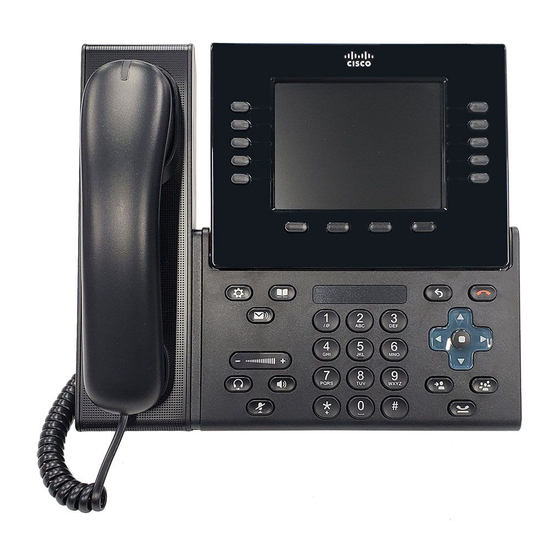What Networking Protocols are Used?
Table 1-4
Supported Networking Protocols on the Cisco Unified IP Phone (continued)
Networking Protocol
Link Layer Discovery
Protocol-Media Endpoint
Devices (LLDP-MED)
Real-Time Transport
Protocol (RTP)
Real-Time Control
Protocol (RTCP)
Session Description
Protocol (SDP)
Session Initiation Protocol
(SIP)
Transmission Control
Protocol (TCP)
Transport Layer Security
Cisco Unified IP Phone 8961, 9951, and 9971 Administration Guide for Cisco Unified Communications Manager 8.5 (SIP)
1-12
Purpose
LLDP-MED is an extension of the LLDP
standard developed for voice products.
RTP is a standard protocol for transporting
real-time data, such as interactive voice
and video, over data networks.
RTCP works in conjunction with RTP to
provide QoS data (such as jitter, latency,
and round trip delay) on RTP streams.
SDP is the portion of the SIP protocol that
determines which parameters are available
during a connection between two
endpoints. Conferences are established by
using only the SDP capabilities that are
supported by all endpoints in the
conference.
SIP is the Internet Engineering Task Force
(IETF) standard for multimedia
conferencing over IP. SIP is an
ASCII-based application-layer control
protocol (defined in RFC 3261) that can be
used to establish, maintain, and terminate
calls between two or more endpoints.
TCP is a connection-oriented transport
protocol.
TLS is a standard protocol for securing
and authenticating communications.
Chapter 1
An Overview of the Cisco Unified IP Phone
Usage Notes
The Cisco Unified IP Phone supports LLDP-MED
on the SW port to communicate information such as:
Voice VLAN configuration
•
Device discovery
•
Power management
•
Inventory management
•
For more information about LLDP-MED support,
see the LLDP-MED and Cisco Discovery Protocol
white paper:
http://www.cisco.com/en/US/tech/tk652/tk701/tech
nologies_white_paper0900aecd804cd46d.shtml
Cisco Unified IP Phones use the RTP protocol to
send and receive real-time voice traffic from other
phones and gateways.
RTCP is disabled by default, but you can enable it
on a per phone basis by using Cisco Unified
Communications Manager.
SDP capabilities, such as codec types, DTMF
detection, and comfort noise, are normally
configured on a global basis by Cisco Unified
Communications Manager or Media Gateway in
operation. Some SIP endpoints may allow these
parameters to be configured on the endpoint itself.
Like other VoIP protocols, SIP is designed to
address the functions of signaling and session
management within a packet telephony network.
Signaling allows call information to be carried
across network boundaries. Session management
provides the ability to control the attributes of an
end-to-end call.
Cisco Unified IP Phones use TCP to connect to
Cisco Unified Communications Manager and to
access XML services.
When security is implemented, Cisco Unified IP
Phones use the TLS protocol when securely
registering with Cisco Unified Communications
Manager.
OL-20861-01

